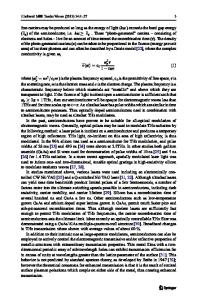Transgressive Shelf Sands around the Korean Peninsula: A Brief Review
- PDF / 14,008,879 Bytes
- 11 Pages / 595 x 842 pts (A4) Page_size
- 110 Downloads / 328 Views
Available online at http://link.springer.com
Review pISSN 1738-5261 eISSN 2005-7172
Transgressive Shelf Sands around the Korean Peninsula: A Brief Review Hee Jun Lee1,2*, Chung Kyun Jeon1, and Hak Soo Lim3 1
Marine Active Fault Research Center, Korea Institute of Ocean Science and Technology, Busan 49111, Korea Department of Convergence Study on the Ocean Science and Technology, Korea Maritime and Ocean University, Busan 49112, Korea 3 Marine Disaster Research Center, Korea Institute of Ocean Science and Technology, Busan 49111, Korea 2
Received 12 July 2020; Revised 31 August 2020; Accepted 3 September 2020 © KSO, KIOST and Springer 2020
Abstract − Sands are distributed in a sheet form across the entire shelf of the Yellow and South seas. They are barely several meters thick except for sand waves and ridges, which are commonly thicker than 10 m. These shelf sands are called transgressive sand deposits (TSDs), which formed during the Holocene. The formation of TSDs can be explained by shoreface retreat, a morpho-dynamical process in response to sea-level rise. This process is accompanied by an intensive erosion of beach/barriers with the eroded sands depositing behind onto tidal or estuarine muddy sediments. The TSDs in the Yellow and South seas may well be traceable to the present coast. As a result, the TSDs reflect successive earlier positions of the coastline. The consequence of the shoreface retreat in the Yellow and South seas is expressed in the Holocene stratigraphy. It shows a somewhat abrupt change in the grain texture of sediments in the upper part. That is, the sediments coarsen upward from mud or muddy sand to massive fine-to-medium sand, i.e. the TSDs. Most of the TSDs are still reworked by strong tidal currents and winter stormy waves as evidenced by asymmetric sand waves of various scale. The Korean coast of the East Sea is characterized by beaches and sand bars in wave-dominant environments. However, the narrow and steep shelf of the East Sea is virtually barren of TSDs. That may be elucidated by a sediment-dynamical finding that shoreface retreat becomes more erosive as the slope gradient increases. Keywords − Holocene transgression, Korean seas, shelf sands, shoreface retreat, stratigraphy
1. Introduction The deposits of detrital sand grains can be found in a wide range of marine environments from coast to deep basin. Most of the riverine sands delivered to the sea accumulate in estuarine or deltaic environments in contrast to suspended *Corresponding author. E-mail: [email protected]
sediments, which are readily exported to the offshore (Dyer 1995). Along the shore, the cliffs of fluvial and alluvial soil may be eroded by wave and currents - thus supplying sand grains through a littoral drift to nearshore environments. These sand-delivery processes are largely restricted within the coastal areas. However, sea-level fluctuations in geological times could make the coastal sandy deposits frequently overlain by offshore/shelf fine-grained sediments in the stratigraphy (Demarest and Kraft 198
Data Loading...











